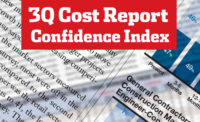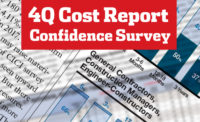The seeming boundless optimism of the construction industry has been sorely tested over the past two and a half years. The market recession that hit nearly every market in every region of the U.S. has cast a pall over the industry, which has seen projects and opportunities dry up, firms large and small fall by the wayside and unemployment rates in the trades of over 20%. The mantra for recovery has been “Wait till next year.”
But amid this gloom, a new sense of hope is beginning to appear in the industry, according to the most recent ENR Construction Industry Confidence Index survey. The CICI for the first quarter of 2011 rose dramatically to 51 on a scale of 100, from 43 last quarter. This uptick represents the first time since ENR began measuring industry sentiment in March 2009 the CICI has risen above 50, which suggests a stable market. The 679 executives of large construction and design firms responding to the survey believe the market has bottomed out and recovery will begin this year.
The CICI measures executive sentiment about the current market and projections for where it will be in the next three to six months and over a 12- to 18-month period. The index is based on responses to surveys sent out to more than 3,000 U.S. firms on ENR’s lists of the leading contractors, subcontractors and design firms. The latest results are based on a survey conducted from Feb. 28 to March 14.
This quarter, 32% of all respondents say the market continues to decline, down from 45% in last quarter’s survey and 63% in the third quarter of 2010. For the first time, general contractors and subcontractors are equally as optimistic as design firms.
This spike in market confidence parallels the findings of the latest CONFINDEX survey, which is about to be released by the Construction Financial Management Association, Princeton, N.J. CFMA polls 200 chief financial officers from general contractors, subcontractors and heavy and civil contractors. “Our CONFINDEX went from 117 to 131 [on a scale of 200] in the first quarter,” says Mike Verbanic, director of marketing at CFMA.
The CONFINDEX is broken down into four indices. The most dramatic spike came in the index measuring current business conditions, which rose to 145 from 129 on a scale of 200. Also rising dramatically was CFOs’ confidence in the general construction outlook, which went to 141 from 132 on a scale of 200. “What makes these indices doubly reassuring is that our members are not wild gamblers, so their responses are measured and based on conditions they see,” says Verbanic.
All We Need Now Is the Cash
However, another of CFMA’s indices has not climbed as high: The financial conditions index, measuring bonding and availability of credit, rose to 116 from 105. “These indices show CFMA members expect demand to increase, but that credit and project financing may lag,” says Anirban Basu, CEO of Baltimore-based economic consultant Sage Policy Group Inc. and an economic adviser to CFMA. He says this may pose a challenge to contractors to manage their cash flow as work increases but credit remains tight.
Applying the CICI formula to individual market sectors, respondents felt that, while the private-sector markets remain sluggish, the recession may be bottoming out. Many participants commented that project financing remains a problem, but the CICI in most of the developer-financed sectors rose. For example, the commercial office sector, still the lowest-ranked sector, rose to 37 from 29 out of 100 on the CICI scale. Other buildings sectors that went up were retail (42), hospitals and heath care (67), distribution and warehouses (47), hotels and hospitality (46), entertainment (44) and, entering positive territory for the first time, multi-unit residential (55).
This growing feeling that the slide in the privately financed project market may be easing suggests the credit crunch may be ending. While 27.6% of respondents said they believed client access to credit continues to be a problem, 51.8% said the availability of credit has stabilized, albeit at a low level, and 20.7% said credit restrictions are beginning to ease.
On the other hand, some buildings markets that are heavily reliant on public financing fell in the CICI scale. The K-12 education sector fell a point to 45, as did higher education, to 54. The infrastructure markets also fell on the CICI scale, with transportation down two points to 48 and water and sewer down two to 55.
This drop in confidence is evidence of state and local government budget deficits around the country. Many respondents say state and local agency budget deficits have affected project starts, with 35.2% saying that publicly funded project starts were off by up to 10%; meanwhile, 24.3% said publicly funded project starts were off by more than 10%. Only 8.7% say that public projects starts were up during the last six months.
Materials prices also are a concern to the CICI survey respondents. This quarter, 80.3% of respondents said they saw some price pressure on materials and equipment. Of the 439 executives that said specific materials were on the rise, steel was mentioned by 242, while copper was mentioned 159 times. Fuel and petroleum products were mentioned by nearly 150 survey participants.
Basu notes that the Producer Price Index has shown significant construction price pressure over the past few months. “The dollar has been softening recently, and there is evidence that commodity speculators have become more active in the metals markets,” he says.
Another area that price pressure may reappear is in compensation. Basu says there should be little pressure to increase wages in the trades, considering the unemployment rate in the industry is still over 20%. However, Verbanic says contractors may feel pressure to reward the managers and staff who held on with few or no raises during the past three years to help keep their firms afloat.




Post a comment to this article
Report Abusive Comment